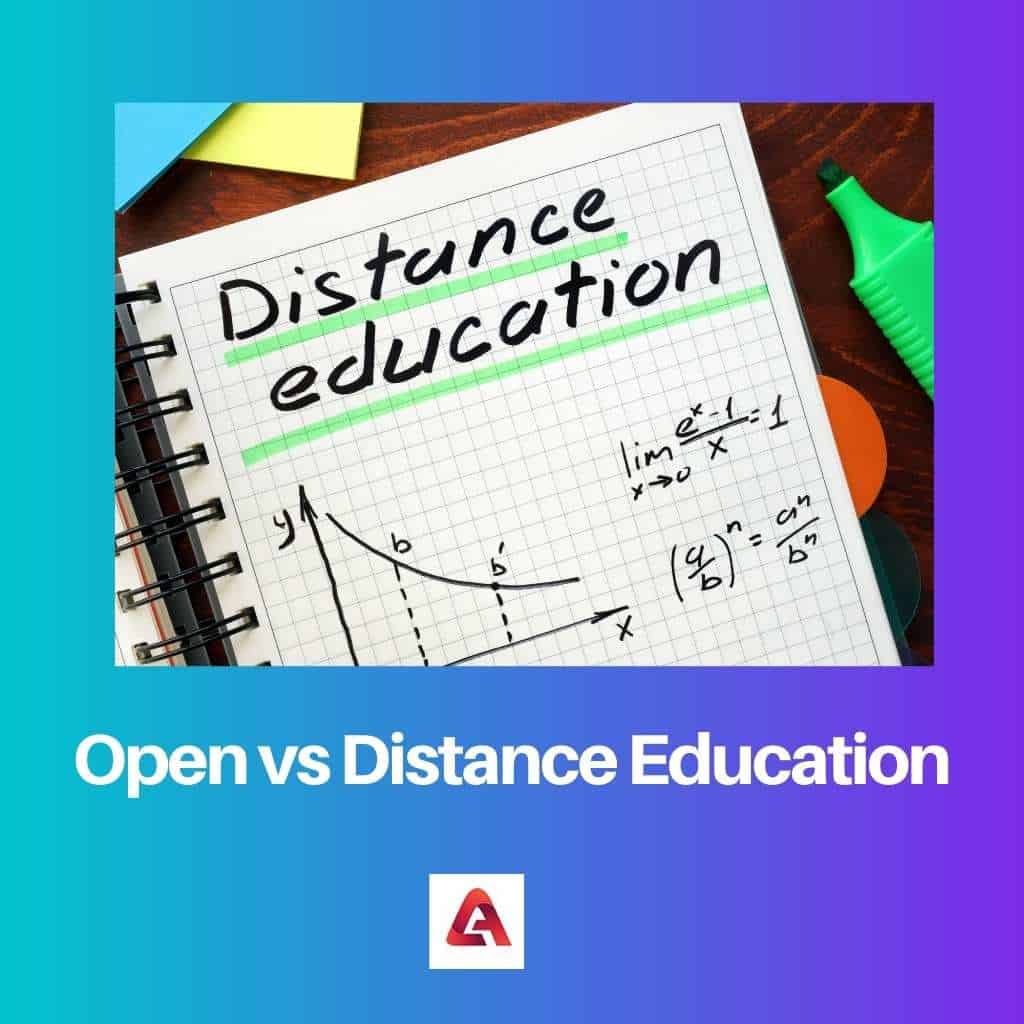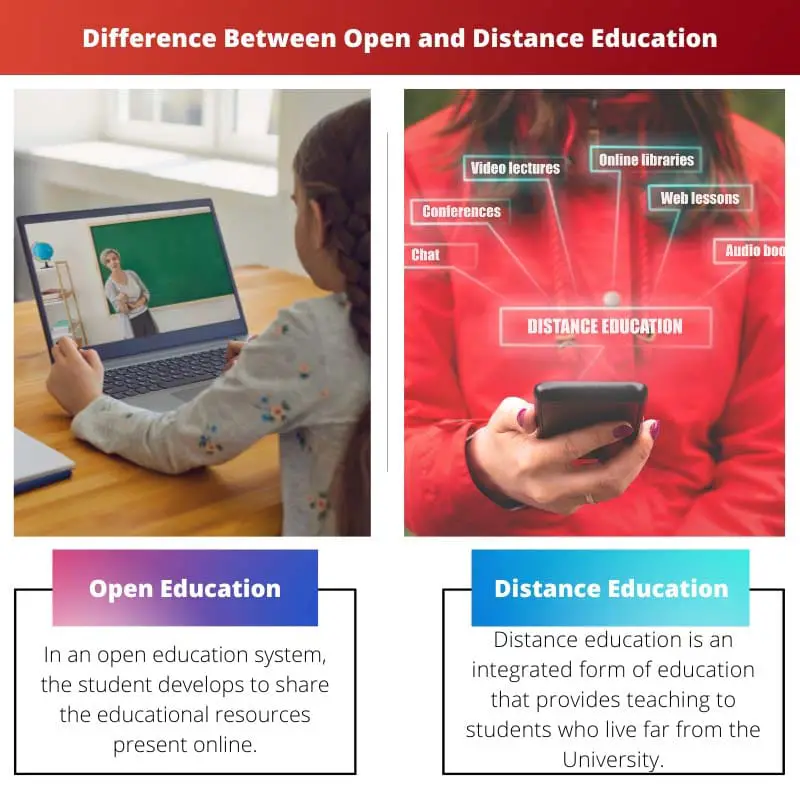While looking at the latest scenario, the education system and methods have evolved much.
Open education has cleared the barrier of minimum qualification marks hence open for all. Distance education is marked as a boon for those students who cannot be admitted to their college only due to long distance.
Key Takeaways
- Open education refers to an educational approach that emphasizes accessibility, flexibility, and removing barriers to learning, utilizing digital technologies and innovative teaching methods. In contrast, distance education is a mode of learning where students and teachers are physically separated, relying on technology to facilitate communication and instruction.
- Open education can include initiatives like open educational resources (OER), open courseware, and massive open online courses (MOOCs), which aim to make educational materials and opportunities more widely available. In contrast, distance education involves structured courses or degree programs offered by institutions through remote learning platforms.
- Both open and distance education can provide greater access to education for learners who may face geographical, financial, or personal constraints. Still, open education emphasizes the democratization of knowledge and the free sharing of educational resources.
Open vs Distance Education
Open education is related to the learning and training of students through an online system. In open education, there are only online courses available for the students. There is no need for physical attendance. Distance education can be online or classroom-based. In distance education, exams are conducted offline.

Open education is a special category of distance education. In an open education system, the student develops to share online educational resources.
Also, open education courses do not impose a minimum educational qualification barrier on the students. Open education builds self-dependency and increases the self-study duration and hunger to learn more and more.
Distance education is an integrated form of education that provides teaching to students who live far from the University. In a distance education program, a student can attend classroom and online classes.
Also, the students will be given study materials via post. Distance learning is known as e-learning, m-learning, virtual learning, and many more.
Comparison Table
| Parameters of Comparison | Open Education | Distance Education |
|---|---|---|
| Qualification | In open education, no limitation of qualification is needed. | In distance education, the college has imposed a minimum qualification which the candidate has to clear. |
| Hybrid learning | Open education does not support hybrid learning as open education is a completely online course. | Distance education works on the hybrid model which includes online as well as classroom-based teaching. |
| Physical presence | In open education, the student need not be present physically in the class. | In distance education, students can attend classroom lectures. |
| Exam Mode | The exams of open education are conducted in online mode. | The exams of distance education are conducted in offline mode. |
| Communication Gap | The communication between students studying in open education is very less and mainly in online mode. | The communication between students studying in distance education is quite more in online and physical mode. |
What is Open Education?
Open education is one of the recent and most updated education reforms. It broadly helps the student access training and learning in many recognized institutions online.
The whole system of open education is based on online and distance education.
Students are provided with educational matters such as written notes, theories, practical videos, a thesis, online lectures, and many more. Meanwhile, this educational reform is now accepted by many worldwide institutions, decreasing the entry barrier into respective colleges.
Open education allows the students to go through the study materials, scholarships, and textbooks which are open to all category students.
This education system helps students to collaborate with their colleagues. These companions or colleagues may belong to different geographical areas or different education systems.
The presently studying students have a full scope of invention and being creative.
Also, the colleagues can share their knowledge and help their mates to get clarification on the respective courses or notes. Mental development is integrated into the student’s mind, enhancing the scope of recreation and development.
Open education is mainly flexible learning which is time flexibility and time-efficient feature. This modern-day reform has built a new structural foundation of evolution in the field of education throughout the world.

What is Distance Education?
Distance learning, commonly known as distance education, is a hybrid form of open education. This applies to those students who are not physically present in the college.
This type of education system is handled by two main steps: correspondence courses and online courses.
In the correspondence course, the students are being provided with written notes and study materials. Nowadays sending a parcel to long-distance has become easier due to many courier facilities.
The correspondence course study material is sent either by courier or by mail.
Modern-day teaching involves online teaching and traditional classroom teaching. So, distance learning can be a combination of traditional classroom learning and online learning and is hence called a hybrid learning system.
A large-scale internet technology named Massive Open Online Courses offers an interactive platform to enhance traditional educational models.
Distance Education is also known as e-learning, virtual learning, and many more synonyms. Distance education increases the student’s need to gain education and adjust their study time compatibility with online classes.
However, many critics support the fact that distance education may need much technical equipment and assets. Those new to this technology may require higher exposure to get familiar with them.

Main Differences Between Open and Distance Education
- In open education, the student needs to search and download their respective study material as well as the notes, whereas, in distance education, the study material and notes are physically sent via mail.
- Open education is carried out for courses above the school level, whereas distance education courses are offered for school and college-going students.
- Open education offers transparency and collaboration of studies, whereas distance education focuses on projection and expression of guidance.
- Open education costs a lesser expenditure of money, whereas distance education may cause more amount of expenditure.
- In open education, a student may develop peer pressure due to competition among the students, whereas in distance education, a student learns to collaborate with their batchmates.

- https://journals.sagepub.com/doi/abs/10.3102/00346543052004579
- http://kvantti.kapsi.fi/Documents/LCL/ERM0811.pdf
- https://ocw.metu.edu.tr/file.php/118/Week10/Gunawardena-McIsaac-distance-ed.pdf
- https://www.tandfonline.com/doi/pdf/10.1080/08923649109526758
